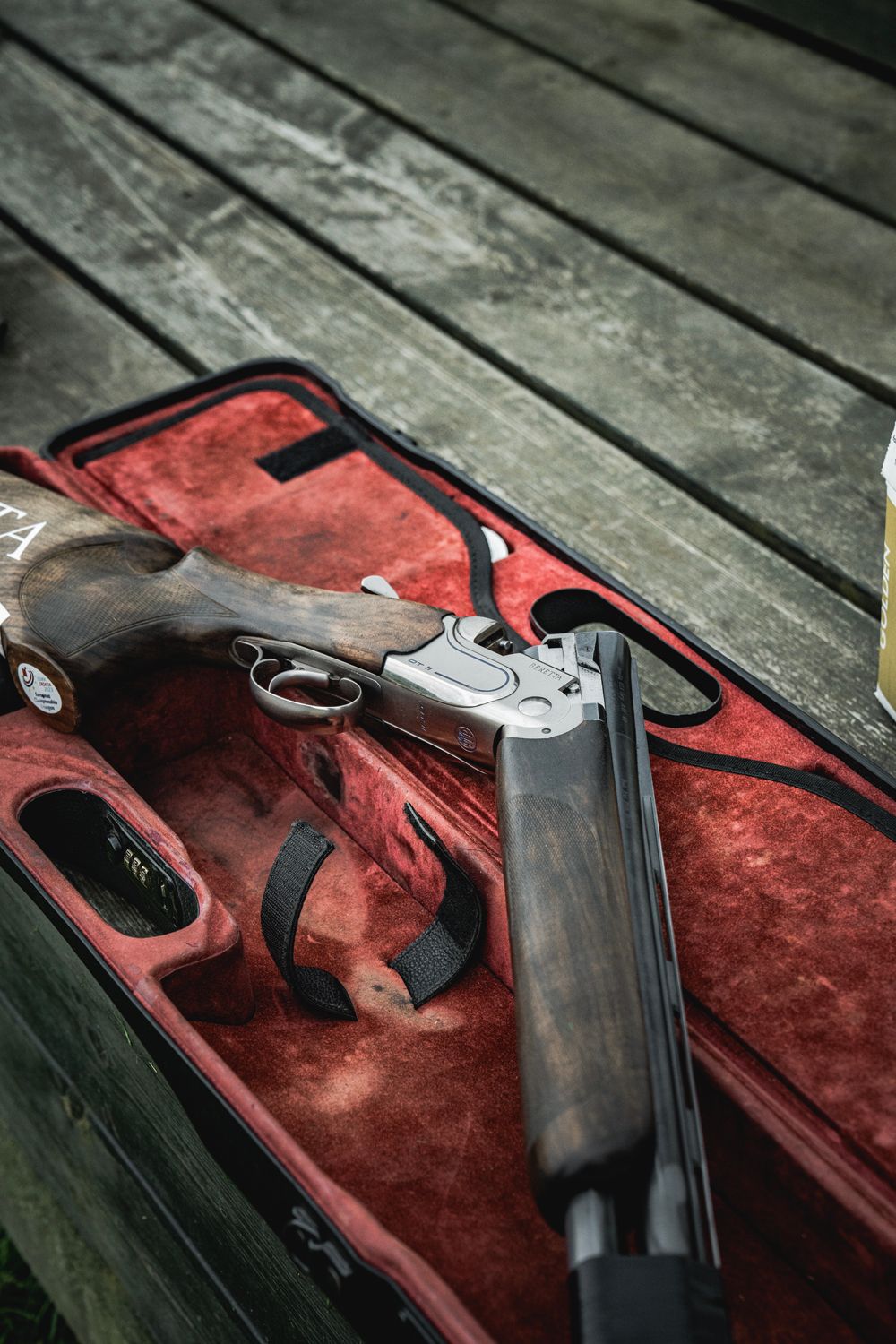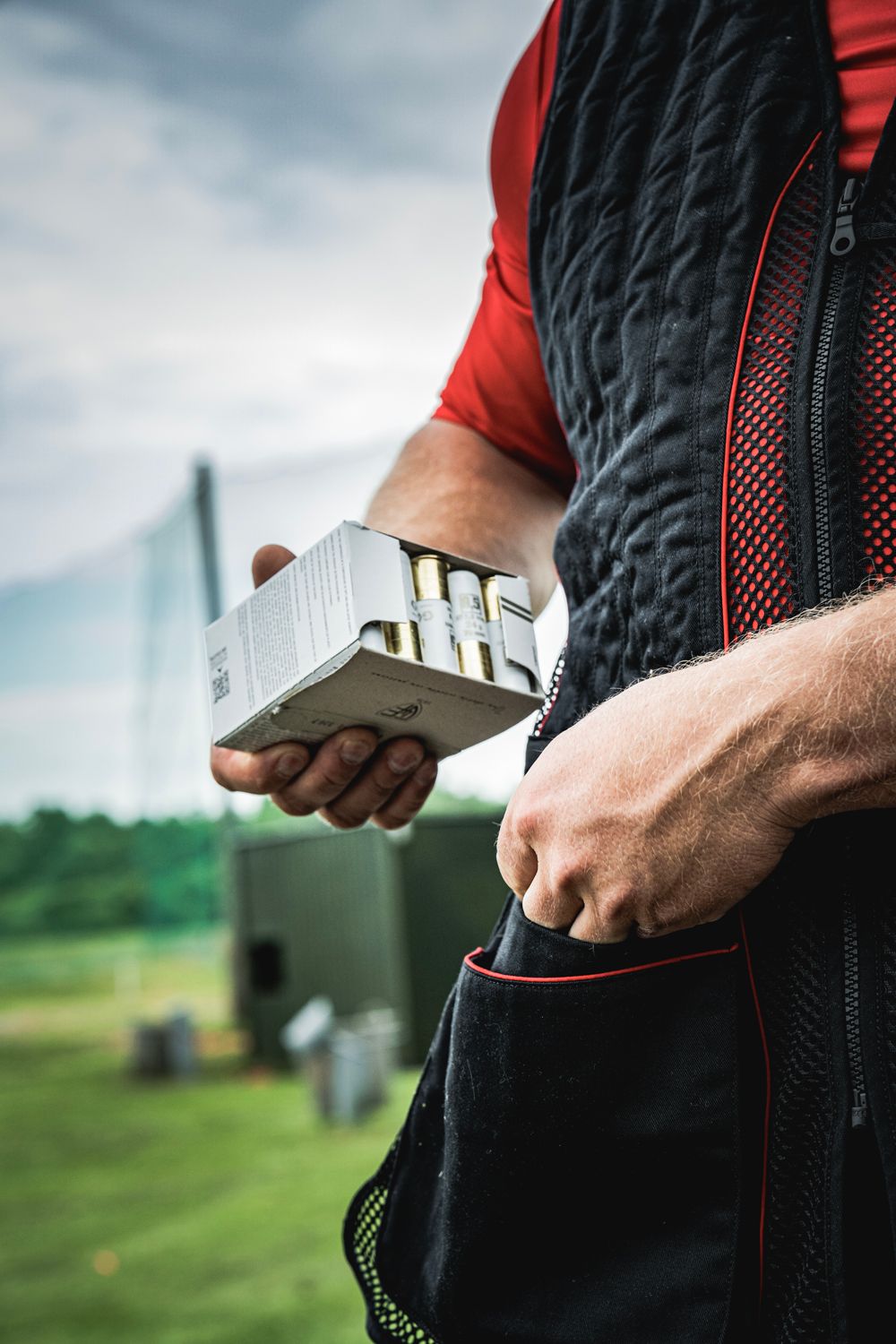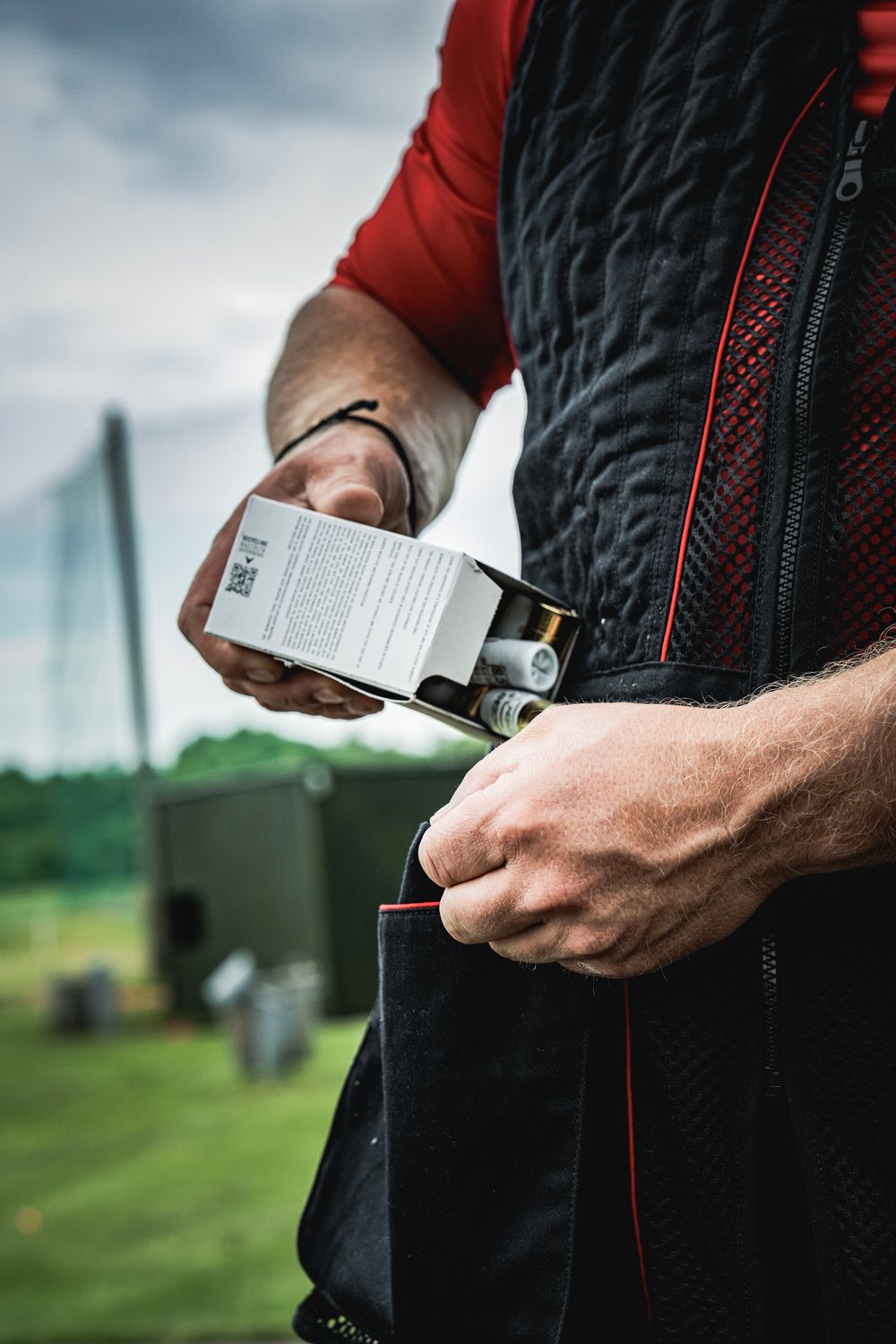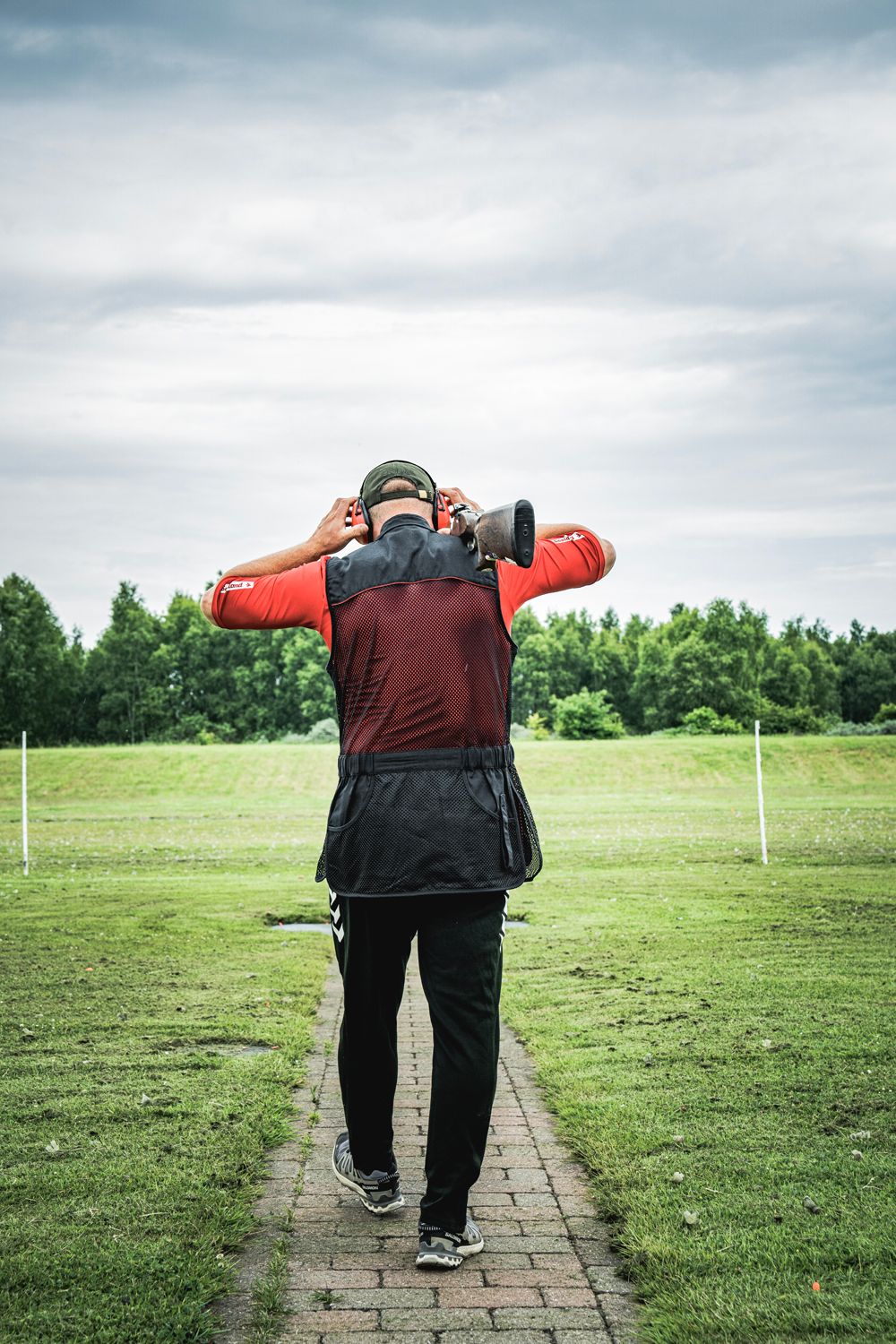Jesper Hansen
"The Devil is in the details... so am I"
European Champion, World Champion, and Olympic Silver Medalist.
Skeet shooting in Olympic style
Skeet shooter Jesper Hansen was the first Dane to be selected by DIF/Team Denmark for the 2024 Paris Olympics, which will be held from 24 July to 11 August. The road to the Olympics is long and paved with training, competitions and an eternal pursuit of perfection.
Shooting a clay pigeon is not just shooting a clay pigeon when you're at Jesper Hansen's level. A level that most of us can only dream of and which requires more hours of training than many people can manage. He is the most winning skeet shooter alive in Denmark, with both World and European Championship gold medals, and has represented Denmark three times at the Olympics so far. This summer he will do it again.
Being at that level requires a constant, continuous focus on the sport, combined with physical training, mental training and of course shooting training. It's all about performing at your highest level, which is why Jesper works closely with a personal trainer, a sports psychologist and a dedicated shooting coach, all of whom help him achieve his goals. Besides 8-10 hours on the shooting range 6-7 days a week, he eats, sleeps and trains with one goal in mind: to be the best.
The sum of their work and his own efforts gives Jesper the confidence in knowing that his preparations are optimal and his gear is optimised down to the last detail. The shotgun is customised to fit him 100%, the vest fits right, feels right when he mounts the gun and the pockets are cut just right, with the seams placed correctly so that the weight of the cartridges doesn't pull him out of balance or feel wrong when he leans into the shot.
The shooting glasses are carefully selected and the lens matches the light, weather and background on competition day. Even the t-shirt, cap, ear defenders, trousers and shoes are of course not something randomly taken from the wardrobe. They've been selected and "broken in" through numerous training sessions and competitions, so he knows they work.
He's not superstitious and doesn't have rituals, like football players who have to put on their left boot before the right, his "rituals" are in the meticulous preparation. Doing exactly the same thing every single time and knowing that everything is exactly as it should be so he doesn't have to think about it.
Even though skeet shooting is considered a niche sport daily, it always draws a lot of attention when Danes travel to represent their country in international competitions, especially at the Olympics. Jesper felt this especially when he secured Denmark's first medal in Tokyo, after several days where other Danish athletes had failed to bring home medals. The journalists were hungry for something good to write about and were practically standing on each other's shoulders to get an interview or just a comment from him. In the following 24 hours, he ended up giving around 60 interviews. Of course, this is part of life as an elite professional athlete and something he is happy to do, but it was still an exhausting 24 hours for the silver medallist.
Just a t-shirt?
An example of Jesper's uncompromising preparation was on a training trip to Brisbane ahead of the Tokyo Olympics. He needed to shoot and test himself and his gear in a climate similar to what he would experience in Japan. The heat combined with the high humidity quickly took its toll on the Danish shooter, sweat was pouring out and he found that the moisture on his skin made the butt of the gun stick to the inside of his arm. It ruined his flow when mounting the shotgun. If you've watched a skeet competition, either on TV or at the local range, or if you're a competitive shooter yourself, you know that it's all about flow and repetition.
"Shooters often look almost "mechanical" as they set up, get ready, mount, shoot, unload, and set up again."
When such a problem arises, which for the rest of us might be "just a bit of sweat", it takes away focus and ruins the rhythm - so, it had to be solved. Fortunately, the solution was simple and straightforward. By lengthening the sleeves of Jesper's t-shirt so that the stock was not in contact with his skin, he was no longer disturbed in his flow. So if you, like the rest of us, didn't notice, try re-watching the clip of Jesper winning the silver in Tokyo and realize that what you thought was "just a t-shirt" is not just a t-shirt. It's a t-shirt adapted to the conditions and to optimize his performance.
Another discovery Jesper made on his trip to Brisbane was the need to bring extra clothes and more than usual. Due to the climate, there weren't many hours in a t-shirt before it was drenched in sweat. Without the extra clothes, he would have to go through the competition in wet clothing and the discomfort would be distracting. In Tokyo, the shooting range was built on an airport runway. Therefore, an underlay was laid out to ensure that EVERYTHING could be removed once the competition was over so that the runway could be used again. The surface was black, which meant that the heat was intensified and reflected onto the shooters. Of course, it was a challenge that was the same for all participants, but for the shooters who didn't have enough dry clothes available, the challenge was greater.
"Even if I hit all the clay pigeons, there are still some I can improve"
For us "regular shooters", a perfect round must be when you manage to hit all the clay pigeons - that's simple enough. But that's just not the case if you're at Olympic level. It's all about the feeling, the flow and not least; perfection. Again, you know it yourself from the clay pigeon course. Some pigeons break and then some disappear in a cloud. Both count as a hit, but the last ones feel the best because they are the ones that are hit cleanest and that's exactly what Jesper talks about and constantly strives for. It feels safe and convincing to see the pigeon disappear in a cloud. Then you know that "you're there" - that you're in the "flow", as he puts it. On the other hand, if the pigeon only breaks a little, it can give cause for doubt. Look at it this way - the less a clay pigeon breaks, the closer you are to NOT hitting it. A pulverised pigeon has received a good amount of pellets, while a broken pigeon has only been hit by a few pellets, perhaps from the edge of the swarm.
It's not just about hitting the second pigeon in the doublé either. It should be taken as early as possible after the first one is shot. The further away it flies, the more the uncertainty and risk of missing, grows. And a miss at the Olympics can mean the difference between a medal or "just" a good placement. Again, there are many opportunities for optimisation and there is nothing that is not being explored. The above-mentioned t-shirt is a good example of this. Of course, it's no coincidence which gun Jesper is using.

And it's not exactly the same as the ones you can pull off the shelves in the hunting shop. You can get the model, but this one was built for Jesper. He shoots a Beretta DT11 Skeet, which is equipped with a Beretta Round fore-end and a Glovegrip stock in grade 3. He shoots with a 12-gauge calibre and a barrel length of 73 centimeters. The stock and grip are customized by Beretta to fit Jesper's hand perfectly. Of course, it's no coincidence which chokes are fitted in the barrels. Jesper uses a Gemini Flush 18.5 (skeet) in one barrel and an 18.1 (equivalent to something between ¼ and skeet) in the other.

Even the cartridges are carefully selected and not just something Jesper is handed on competition day. He uses Fiocchi Golden lead shot 24g. in size 9.5 for most shots, but he has built some cartridges with shot size 7.5 that hit a bit harder, which he uses when shooting the reverse doublé's in the final. He keeps these cartridges in a separate pocket in his shooting waistcoat. They are used for the second shot, where the last pigeon must be hit. That pigeon usually flies a little further than the first one and therefore has to be " picked up" a little further out. It's nice to have some cartridges with a little extra punch, so there's no doubt as to whether the pigeon is hit properly. The cartridges, from pellet size, pellet bowl, charge and even how the cartridge is closed, have been developed over a whole year in close collaboration with Jesper, and tested with the selected chokes to ensure optimal spread. The cartridges are actually built from scratch based on Jesper's specifications and each one has to be weighed before the competition to ensure that they comply with ISSF rules.

"As long as I feel like it, I'll keep going"
There is, as such, no expiry date for skeet shooters as we know it from, for example, football players, who usually approach retirement age when they are around 35 years old. Jesper Hansen is 43 years old today and if you compare him to the oldest professional skeet shooter, Abdullah Alrashidi from Kuwait, who is 60 years old and won the bronze medal in Tokyo, 43 is nothing.
Jesper has no plans to put the shotgun in the gun cabinet any time soon. As long as he's motivated and the desire is there, he'll keep going, even though life as a professional skeet shooter is demanding. It's a sometimes rootless existence with a lot of training, mental challenges and competitions all over the world. Life is often packed into a travelling bag, in a hotel, a shooting range or on the way to or from the airport.
When life as a professional skeet shooter shows its hectic side, Jesper uses a simple tool - something as analogue as a good book, which he uses to disconnect, and zone out, either on the plane or in the hotel room or even during competitions where he needs to zone out between rounds.

The pandemic & new beginnings
The last 7 years have been particularly challenging as the Tokyo Olympics were postponed to 2021. This coincided with other competitions and disrupted the rhythm, so the "break year" Jesper usually gets after an Olympics didn't come. That's why he's looking forward to getting on the other side of this summer's Olympics in Paris, so he can take a breather, even though there's never really an off season as a skeet shooter and dedication must be kept at a maximum if you want to remain among the best.
Although Jesper is 110% dedicated to his sport, he also finds time for other things and has started to prepare for the life that follows his professional career. While the dedication, seriousness and amount of training matches any other professional sport, skeet shooting is unfortunately not something that pays huge salaries.
Fortunately, Jesper is really passionate about shooting and loves to learn. That's why he started the company "The Elite Experience - by Jesper Hansen", which offers customized events with simulated game days that can take place at the customers' hunting grounds or shooting events with catering at the Copenhagen clay shooting grounds. Whether you choose one or the other, you get both instruction and guidance from Jesper to develop your shooting, an insight into his career and lifestyle, and as many stories as you want, while you are there.
Thankfully, Jesper also finds time to go hunting. Not quite as much as he would like, but he gets out when time allows. Hunting has always been a part of his life. That's where it all started when he, like many other boys from his hometown, went hunting with his father and spent many hours in the nature and of course also in the hunting lodge, where inspiring hunting stories were not in short supply. Later, the hours were spent on the skeet shooting range, and from there he has not looked back. The latest thing to happen in Jesper's hunting life is that the shotguns have been joined by a rifle in the gun cabinet. From all indications, rifle hunting has not been a big part of Jesper's hunting life until now, but after much persuasion from his hunting friends, Jesper finally got his rifle license and for the first time in a long time, he is actually the "less experienced" one out on the shooting range. But it may not be for long.
According to Jesper, the rifle will continue to play second fiddle in his hunting life, despite shooting over 80,000 rounds a year with a shotgun for training and competition, he never tires of it and still prefers shotgun hunting. Despite what you might think, it's not pheasants that he prefers to shoot. There's a lot more action on the fast-flying pigeons, which is why Jesper enjoys getting out in a blind and shooting pigeons on the move. It's a form of hunting that places high demands on attention and shooting when the well-flying birds have to be brought to to the ground. Pigeons are unpredictable in their flight, unlike pheasants, which are a little more "polite" and usually keep their direction. Once the pigeons get going, Jesper has seen plenty of experienced "pheasant shooters" get challenged, when the peg on the shoot is replaced with the dove blind. It's also a form of hunting that brings the professional skeet shooter back to where it all started and where, for a while, he's just "the boy from Svebølle" again.